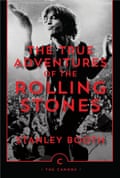As a group of Hells Angels beat and stabbed a Black teenager to death a few feet away from where the Rolling Stones were playing on warm evening in California in 1969, the writer Stanley Booth watched the mayhem from a vantage point next to his friend Keith Richards’s guitar amplifiers.
The murder of 18-year-old Meredith Hunter by thugs hired to act as security men for the Stones’ free concert at Altamont Speedway marked an end to the peace-and-love idyll of the 1960s. It also gave Booth a dramatic climax to the book he would write about the Stones and their rise from London’s clubs to worldwide success and notoriety.
The Stones embraced Booth, who has died aged 82, not least because he represented an authentic connection to the blues music from which they had taken their inspiration. He had been brought up in Memphis, Tennessee, one of the music’s centres, and knew many of the musicians whose work they admired and imitated.
Long-haired, silk-scarved and thoroughly familiar with mood-altering substances, he was perfectly in sync with the social currents they embodied. He met them when, having established himself as a contributor to major American magazines, he travelled to London in 1968 to cover the trial of their founder, Brian Jones, who had been charged with possession of cannabis. “I wrote a story,” he recalled many years later, “but I had only glimpsed – in Brian’s eyes as he glanced up from the dock – the mystery of the Rolling Stones.”

That mystery was the subject of the book he planned to write when he joined the Stones on tour in the US the following year. He slipped so easily into their inner circle that soon they were inviting him to share not just their confidences – Anita Pallenberg told him that Jones had missed shows and recording sessions because he had broken his hand while hitting her – but their drugs. When a fan handed Charlie Watts a yellow-green LSD tab, Booth wrote that “Charlie asked, ‘D’you want it?’ ‘I ain’t too sure about this street acid,’ I said. ‘Maybe Keith will want it.’”
Published in 1974 as Dance With the Devil, and republished in the UK in 1985 as The True Adventures of the Rolling Stones, his book brought to bear an observant eye and literary skills that elegantly stripped the varnish off the story, leaving posterity with a faithful eye-witness account of the group’s activities and their social milieu during their prime years.
Booth was born in Waycross, Georgia, near the Okefenokee swamp, a vast wetland straddling the border with Florida. His father, Irving, was the vice-president of an insurance company, while his mother, Ruby (nee McClellan), was a schoolteacher. He studied English at Memphis State University and remembered being thrown out of a Ray Charles show for sharing a table with some Black fellow students. He began postgraduate studies at Tulane University in New Orleans before breaking off in 1964 to return to Memphis, where he began his career as a journalist.
His background, his love of music and his social circle gave him access to local subjects that interested the editors of national magazines. In 1968 Esquire published his description of Elvis Presley’s life among his courtiers: “When he puts the cigar between his teeth a wall of flame erupts before him. Momentarily startled, he peers into the blaze of matches and lighters offered by willing hands. With a nod, he designates one of the crowd, who steps forward, shaking, and then, his moment of glory, of service to the King, at an end, he retires into anonymity. ‘Thank ya very much,’ says Elvis.”
Typically, the real interest comes when Booth aims slightly away from the target. The source of the best Elvis anecdotes is Dewey Phillips, the first radio DJ to play Presley’s records, found by the author working in a furniture store 20 years after his heyday. One of those tales, involving the actress Natalie Wood, was too ripe for the Esquire piece but is included in Rythm Oil, a collection of Booth’s magazine pieces published in 1994.
The book’s UK edition opened with a mood-setting series of colour photographs taken by William Eggleston, Booth’s friend and fellow Memphian: freight trains, cotton fields, diners and lonesome highways. The pieces included portraits of other local musicians, including the bluesman Furry Lewis, who had spent decades sweeping the city’s streets, and the ill-starred jazz pianist Phineas Newborn.
For all his warm empathy with most of the musicians he encountered, there was also evidence of the essential splinter of ice in the writer’s heart. About his piece for Rolling Stone on Janis Joplin’s poorly received visit to Memphis in 1969, he later reflected: “She died, so I hear, bearing me ill will. Can’t please everyone.”
With a reputation, according to the Memphis Commercial Appeal newspaper, as “a libertine and a wild man”, in 1971 he was fined for growing his own marijuana and broke his back a few years later after falling down a waterfall in Georgia while high on LSD. A second collection of pieces, Red Hot and Blue, was published in 2019 and he leaves an unfinished memoir and unpublished biographies of the songwriter Johnny Mercer and the singer Gram Parsons, a friend who was also from Waycross.
Booth was married three times. After the death in 2014 of his third wife, the poet Diann Blakely, with whom he had lived in Georgia and Florida, he returned to Memphis. He is survived by a daughter, Ruby Booth, from another relationship.
Source: theguardian.com


